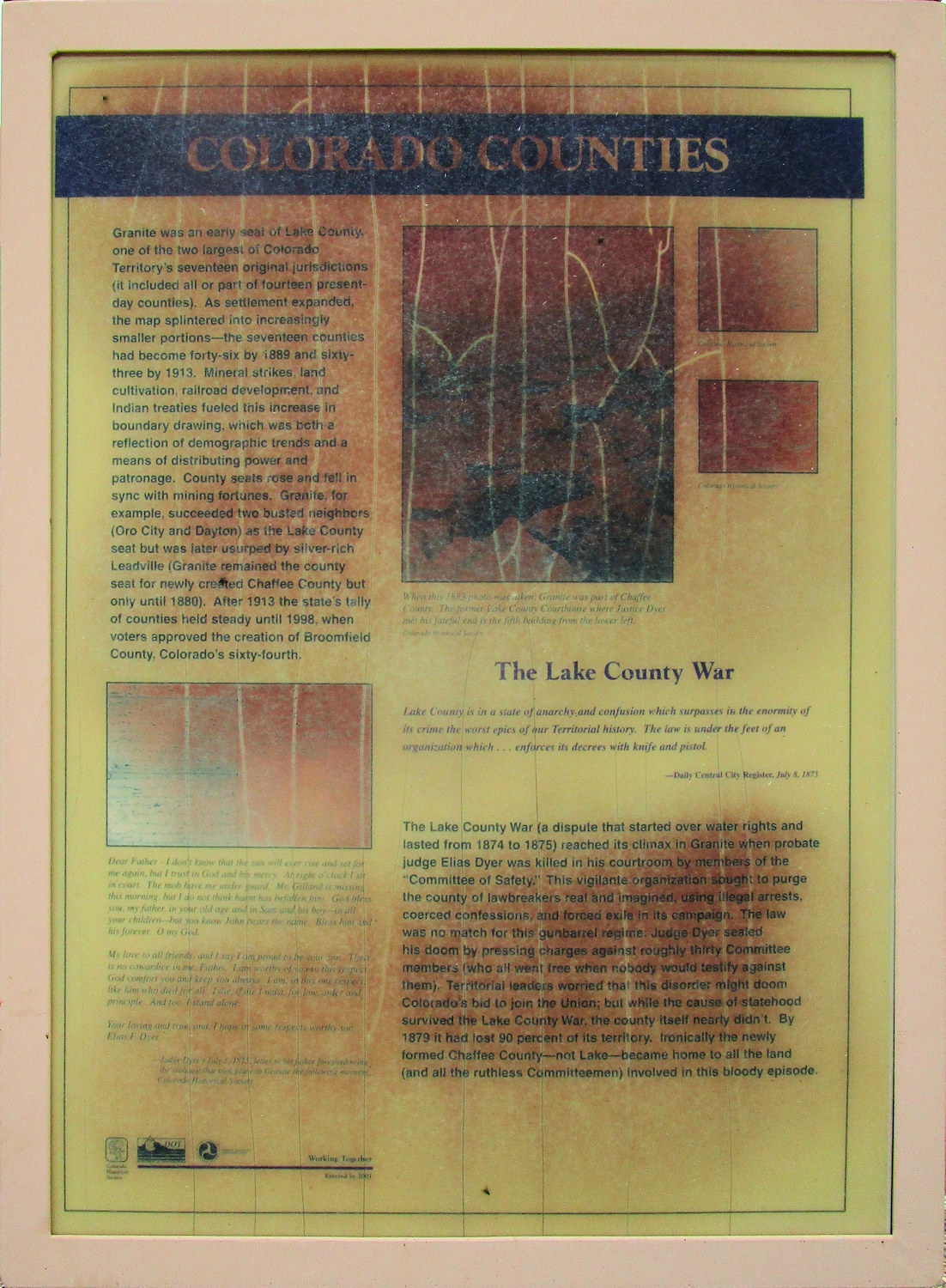
If you have a question or a comment about this photograph you may write to me at:
tomas@schweich.com
I sometimes post interesting questions in my FAQ, but I never disclose your full name or address.
|

Photographed 24 July 2018.
Colorado Counties
Granite was an early seat of Lake County,
one of the two largest of Colorado Territory's seventeen
original jurisdictions
(it included all or part of fourteen present-day counties).
As settlement expanded,
the map splintered into increasingly smaller portions —
the seventeen counties had become forty-six by 1889
and sixty-three by 1913.
Mineral strikes, land cultivation, railroad development,
and Indian treaties fueled this increase in boundary drawing,
which was both a reflection of demographic trends
and a means of distributing power and patronage.
County seats rose and fell in sync with mining fortunes.
Granite, for example, succeeded two busted neighbors
(Oro City and Dayton)
as the Lake County seat
but was later usurped by silver-rich Leadville
(Granite remained the county seat for newly created Chaffee County
but only until 1880).
After 1913 the state's tally of counties held steady until 1998,
when voters approved the creation of Broomfield County,
Colorado's sixty-fourth.
|
The Lake County War
Lake County is in a state of anarchy and confusion
which surpasses in the enormity of its crime
the worst epics of our territorial history.
The law is under the feet of an organization which ...
enforces its decrees with knife and pistol.
— Daily Central City Register,
July 8, 1874
The Lake County War
(a dispute that started over water rights and laster from 1874 to 1875)
reached its climax in Granite when probate judge Elias Dyer
was killed in his courtroom by members of the
“Committee of Safety.”
This vigilante organization sought to purge
the county of lawbreakers real and imagined,
using illegal arrests,
coerced confessions,
and forced exile in its campaign.
The law was no match for this gunbarrel regime:
Judge Dyer sealed his doom by pressing charges against roughly
thirty Committee members
(who all went free when nobody would testify against them).
Territorial leaders worried that this disorder might doom
Colorado's bid to join the Union;
but while the cause of statehood survived the Lake County War,
the county itself nearly didn't.
By 1879 it had lost 90 percent of its territory.
Ironically the newly formed Chaffee County — not Lake —
became home to all the land
(and all the ruthless Committeemen)
involved in this bloody episode.
|
Dear Father –
I don't know that the sun will ever rise and set for me again,
but I trust in God and his mercy.
At eight o'clock I sit in court.
The mob have me under guard.
Mr. Gilland is missing this morning,
but I do not think harm has befallen him.
God bless you, my father, in your old age and in Sam and his boy —
in all your children — but you know John bears the name.
Bless him and his forever. O my God.
My love to all friends, and I say I am proud to be your son.
There is no cowardice in me, Father.
I am worthy of you in this respect.
God comfort you and keep you always.
I am, in this one respect like him who died for all.
I die, if die I must, for law, order and principle.
And too, I stand alone.
Your loving and true and, I hope, some respects worthy son.
Elias F. Dyer
— Judge Dyer's July 3, 1875,
letter to his
father foreshadowing the violence
that
took place the following morning.
Colorado Historical Society.
|
Location records that use this photograph:
Article records that use this photograph:
Other photos about Geography - Colorado or Lake County, History.
|
|
[Home Page]
Date and time this page was prepared:
5/12/2025 3:02:45 PM
|
|
 Eastern Mojave Vegetation
Eastern Mojave Vegetation
 Eastern Mojave Vegetation
Eastern Mojave Vegetation

